Count of Wisborg
Last updated


Count of Wisborg (French : Comte de Wisborg; Swedish : Greve af Wisborg; German : Graf von Wisborg) is a title granted by the monarchs of Luxembourg to some men formerly titled as princes of Sweden and their descendants.
Contents
- The original four Counts of Wisborg
- First creation, 1892–present
- Extended creation, 1951–present
- Later title-holders
- See also
- References
Since 1892, the title has been borne by the male-line descendants of four princes of Sweden who married without the consent of the King of Sweden and thereby lost their right of succession to the throne of Sweden for themselves and their descendants, and had their Swedish royal titles prohibited. [1]
The four former princes of Sweden, after use of their Swedish titles no longer was allowed, assumed the surname of Bernadotte. In each case they were given the title of nobility Prince Bernadotte, Count of Wisborg by the reigning Grand Duke or Grand Duchess of Luxembourg. [2] [3] The latter title (count or countess) was shared with the children of each prince, since subsequent generations in the male line were authorized to bear only the title "Count of Wisborg", Bernadotte being recognized as their surname by birth. [2] In some cases, this titulature has not been adhered to, usage of the style Count [Firstname] Bernadotte af Wisborg having been adopted by some of the descendants. [2]
In Sweden, a few of these people from the House of Bernadotte have been considered members of the unintroduced nobility, and have thus been members of a private club called Ointroducerad Adels Förening. Their legitimate titles of nobility, however, have not been Swedish but Luxembourgish.
The original four Counts of Wisborg
Four original princes of Sweden were admitted in the nobility of the Grand Duchy of Luxembourg and given the title Count of Wisborg: [2]
First creation, 1892–present
- Prince Oscar, Duke of Gotland (1859–1953), second son of King Oscar II of Sweden. He married morganatically and gave up his Swedish titles on March 15, 1888. He and his wife were invested with the new titles of Prince and Princess Bernadotte on their wedding day. [4] It has never been determined if this was a Swedish title of nobility or another form of unofficial courtesy title (such as some later dynasty members have been given by Swedish kings). On 2 April 1892, named as Oscar Prince Bernadotte, he was also given a hereditary title as Count of Wisborg by his uncle Adolphe, Grand Duke of Luxembourg, previously Duke of Nassau. Oscar's mother, Queen Sofia of Sweden, was a half-sister of Grand Duke Adolphe. [5] The choice of the Wisborg title was because Oscar was formerly Duke of Gotland and the castle of Visborg (then spelled Wisborg) is in Gotland.
Extended creation, 1951–present
- Prince Lennart, Duke of Småland (1909–2004), only son of Prince Wilhelm, Duke of Södermanland and a grandson of King Gustaf V of Sweden. He married morganatically and had his Swedish titles prohibited on March 11, 1932. He was given the same titles as his granduncle Oscar by Grand Duchess Charlotte of Luxembourg on July 2, 1951. [6] Lennart styled himself in no other language than German, and then as Prof. Dr. h.c. mult. Lennart Graf Bernadotte af Wisborg (Professor and multiple honorary doctor Lennart Count Bernadotte of Wisborg).
- Prince Sigvard, Duke of Uppland (1907–2002), second son of King Gustaf VI Adolf of Sweden. He married morganatically and had his Swedish titles prohibited on March 8, 1934. He was given the same titles as his cousin Lennart simultaneously by Grand Duchess Charlotte of Luxembourg on July 2, 1951. On May 28, 1983 Sigvard in Sweden formally announced his title as Prince Sigvard Bernadotte. His nephew King Carl XVI Gustaf of Sweden has consistently declined to respond [7] and his court has refused to use that title for his uncle.
- Prince Carl Johan, Duke of Dalarna (1916–2012), fourth son of King Gustaf VI Adolf of Sweden. He married morganatically and relinquished his Swedish titles on February 19, 1946. He was ennobled just as his brother Sigvard by Grand Duchess Charlotte of Luxembourg on July 2, 1951. He was the last surviving great-grandchild of Queen Victoria of the United Kingdom.
A fifth prince of Sweden, Prince Carl, Duke of Östergötland (1911–2003), only son of Prince Carl, Duke of Västergötland and grandson of King Oscar II, married morganatically and relinquished his Swedish titles in 1937. He was given the title Prince Bernadotte by his brother-in-law King Leopold III of Belgium. His male-line descendants would have borne the title Count Bernadotte, but in fact his only child is a daughter (Mrs. Madeleine Kogevinas, Countess Madeleine Bernadotte).
Later title-holders

The agnatic (male-line) descendants of each of these four former princes of Sweden, after the first generation of children, are entitled to the title Count of Wisborg, but in practice, their surname is often included in the title, Count Bernadotte af Wisborg. [2]
The most well-known is Folke Bernadotte, a son of Oscar Bernadotte, the first Count of Wisborg. He was the United Nations Security Council mediator in the Arab–Israeli conflict of 1947–1948, assassinated in 1948 by Zionist militants.
A number of members of these families were guests at the 2010 Wedding of Victoria, Crown Princess of Sweden, and Daniel Westling. [8]
- Marianne Bernadotte, widow of Sigvard.
- Count Michael Bernadotte af Wisborg (son of Sigvard), his wife Countess Christine Bernadotte af Wisborg and their daughter Countess Kajsa Bernadotte af Wisborg.
- Carl Johan Bernadotte (above, son of King Gustaf VI Adolf) and his wife Gunnila Bernadotte.
- Countess Bettina Bernadotte af Wisborg (daughter of Lennart) and her husband Philipp Haug.
- Count Björn Bernadotte af Wisborg (son of Lennart) and his wife Countess Sandra Bernadotte af Wisborg.[ citation needed ]
- Count Bertil Bernadotte af Wisborg (son of Folke) and Countess Jill Bernadotte af Wisborg.
See also
Related Research Articles

Oscar II was King of Sweden from 1872 until his death in 1907 and King of Norway from 1872 to 1905.

Carl XVI Gustaf is King of Sweden.

The House of Bernadotte is the royal family of Sweden, founded there in 1818 by King Charles XIV John of Sweden. It was also the royal family of Norway between 1818 and 1905. Its founder was born in Pau in southern France as Jean Bernadotte. Bernadotte, who had been made a General of Division and Minister of War for his service in the French Army during the French Revolution, and Marshal of the French Empire and Prince of Ponte Corvo under Napoleon, was adopted by the elderly King Charles XIII of Sweden, who had no other heir and whose Holstein-Gottorp branch of the House of Oldenburg thus was soon to be extinct on the Swedish throne. The current king of Sweden, Carl XVI Gustaf, is a direct descendant of Charles XIV John.
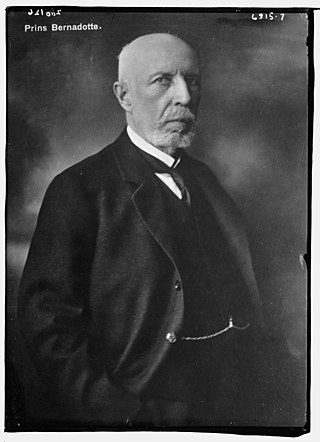
Prince Oscar Carl August Bernadotte, Count of Wisborg was a Swedish religious activist, the second son of King Oscar II of Sweden and his consort, Sofia of Nassau. Born as a Prince of Sweden and Norway, he was known as Prince Oscar, Duke of Gotland. However, by marrying contrary to Swedish constitutional requirements, he lost those titles, becoming instead Luxembourgish nobility as Prince Bernadotte and Count of Wisborg.

Carl Gustaf Oscar Fredrik Christian, Prince Bernadotte, originally Prince Carl, Duke of Östergötland, was the youngest child and only son of Prince Carl of Sweden and Princess Ingeborg of Denmark and eventually a prince of the Belgian nobility. To distinguish himself from his father, he was widely known as Carl Junior. He was the brother of Princess Margaretha of Sweden, Queen Astrid of Belgium and Crown Princess Märtha of Norway.
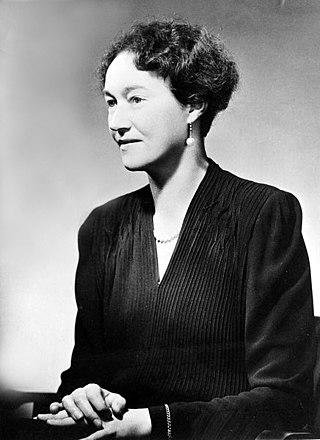
Charlotte was Grand Duchess of Luxembourg from 14 January 1919 until her abdication on 12 November 1964.

The Swedish royal family since 1818 has consisted of members of the Swedish Royal House of Bernadotte, closely related to the King of Sweden. Today those who are recognized by the government are entitled to royal titles and styles, and perform official engagements and ceremonial duties of state. The extended family of the King consists of other close relatives who are not royal and thus do not represent the country officially.
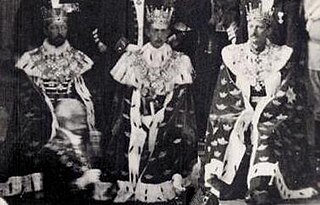
Duchies in Sweden have been allotted since the 13th century to powerful Swedes, almost always to princes of Sweden and wives of the latter. From the beginning these duchies were often centers of regional power, where their dukes and duchesses had considerable executive authority of their own, under the central power of their kings or queens regnant. Since the reign of King Gustav III the titles have practically been nominal, with which their bearers only rarely have enjoyed any ducal authority, though often maintaining specially selected leisure residences in their provinces and some limited measure of cultural attachment to them.

Lennart, Prince Bernadotte, Count of Wisborg was a Swedish-German landscaper, filmmaker, photographer and was a grandson of King Gustaf V of Sweden. He was also the eldest great-grandchild of King George I of Greece.
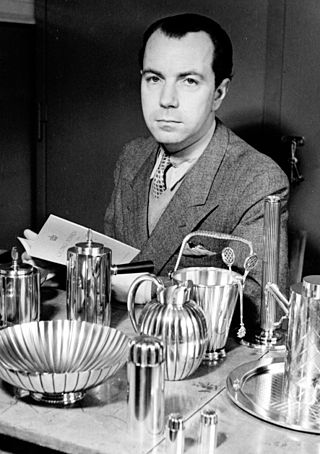
Sigvard Oscar Fredrik, Prince Bernadotte, Count of Wisborg born as, and until 1934 known as, Prince Sigvard of Sweden, Duke of Uppland, was a member of the Swedish Royal Family and a successful industrial designer by profession.
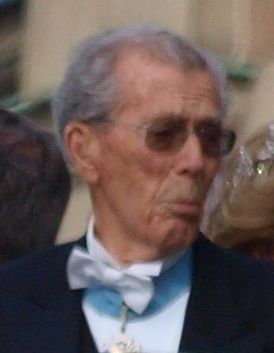
Carl Johan Arthur, Prince Bernadotte, Count of Wisborg, was the fourth son and fifth and youngest child of King Gustaf VI Adolf of Sweden and his first wife, Princess Margaret of Connaught.

Visborg (Wisborg) refers to a fortress in the town of Visby on the Swedish island of Gotland. Successive fortresses were built in Visby, though Visborg is usually in reference to the castle built here by King Eric of Denmark, Norway, and Sweden.

Gullan Marianne, Princess Bernadotte, Countess of Wisborg, also known as Princess Marianne Bernadotte, is a Swedish actress, fashion icon and philanthropist who in 1961 married Sigvard Bernadotte, the second son of Gustaf VI Adolf of Sweden. Since the death of Gunnila Bernadotte in 2016, she is the last surviving aunt of King Carl XVI Gustaf of Sweden. She is officially included in the Swedish royal family, and on 23 January 2022, she surpassed her late sister-in-law Princess Lilian, Duchess of Halland, as the longest-living member on record of the royal family with the age of 97 years and 192 days.

Kungliga begravningsplatsen, known in English as the Royal Cemetery, was first used in 1922 and has been the only official burial place of the Swedish royal family since 1950, succeeding Riddarholmen Church as such. It takes up all of the small island of Karlsborg in the bay of Brunnsviken. The cemetery is part of the popular Haga Park in Solna, Sweden.
The following lists events that happened during 1951 in the Grand Duchy of Luxembourg.

Estelle Bernadotte, Countess of Wisborg (1928–1973), also known as Estelle Ekstrand, was an American-Swedish countess who was a leading figure in the International Red Cross and Girl Scout movement. She married Count Folke Bernadotte, a Swedish member of a United Nations mediating team. He was assassinated by the extremist Zionist Stern gang while on duty in Israel in September 1948.
Prince Bernadotte is a title that has been used by several members of the House of Bernadotte. It is most commonly known as a title granted to men who were formerly titled as princes of Sweden before losing their royal titles when they married unequally and against the Swedish constitution. It was created in 1892 as a non-hereditary title in the nobility of Luxembourg and conferred upon Oscar Bernadotte by Adolphe, Grand Duke of Luxembourg. A title with the same name was subsequently created in 1937 as a non-hereditary title in the nobility of Belgium and conferred upon Carl Bernadotte by King Leopold III of Belgium. The wives of these princes of Luxembourgish and Belgian nobility were then granted the title of Princess Bernadotte. The title was also used in the early 19th century with reference to Jean Baptiste Jules Bernadotte, the subsequent founder of the Swedish royal House of Bernadotte.

Gunnila Märta Louise Bernadotte, Countess of Wisborg was a Swedish and Luxembourgish noblewoman.

A royal christening gown is an item of baptismal clothing used by a royal family at family christenings. Among those presently using such a gown are the royal families of the United Kingdom, Denmark, the Netherlands, Norway, Spain, and Sweden. In most of these families, the tradition goes back over a century: as of 2019, the Swedish gown has been in service for 113 years, the Dutch gown for 139 years, and the Danish gown for 149 years; the current British gown has been in use since 2008. The Spanish gown has been in use for 81 years.

The wedding of Carl XVI Gustaf, King of Sweden, and Silvia Sommerlath took place on Friday, 19 June 1976 at Storkyrkan. Carl XVI Gustaf had been king of Sweden since 1973 and Sommerlath was a German-born translator. The couple had met at the 1972 Summer Olympic Games in Munich and became engaged in 1976.
References
- ↑ Gunnar Bramstång in ''Tronrätt, bördstitel och hustillhörighet ISBN 91-544-2081-4 p. 54-55
- 1 2 3 4 5 Montgomery-Massingberd, Hugh (1980). "Addendum: Burke's Royal Families of the World Volume I: Europe & Latin America". Burke's Royal Families of the World: Volume II Africa & the Middle East. p. 317. ISBN 0-85011-029-7.
- ↑ The Royalty, peerage and aristocracy of the world, Vol 90
- ↑ Burke's Royal Families of the World vol. I 1977, p. 512.
- ↑ Lettres Patentes du Grand Duc Adolphe 1892-04-02
- ↑ Mémorial Archived 2015-07-21 at the Wayback Machine du Grand Duché de Luxembourg 1951-08-13 p 1135
- ↑ Marianne Bernadotte in Glimtar och scener Norstedts Stockholm 1986 ISBN 91-1-863442-7 (Swedish)
- ↑ Stockholm News Archived 2010-06-19 at the Wayback Machine
Text is available under the CC BY-SA 4.0 license; additional terms may apply.
Images, videos and audio are available under their respective licenses.